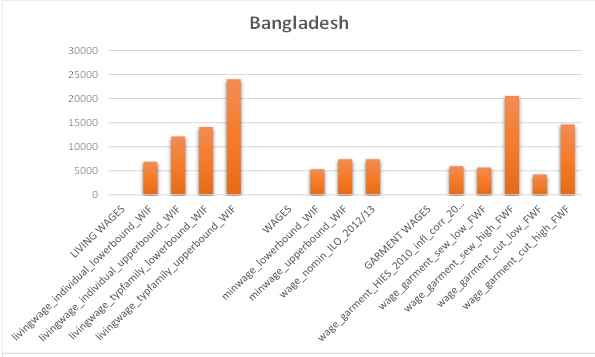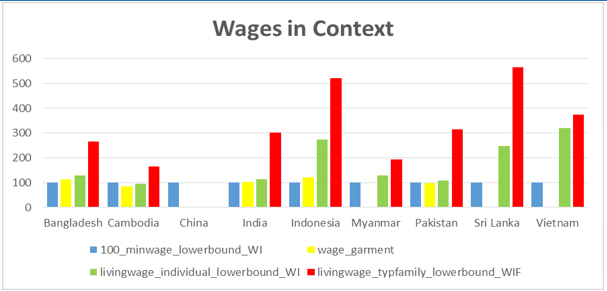1. HOW TO ATTAIN THE LIVING WAGE IN BANGLADESH
According to the experts for Bangladesh we surveyed, Living Wages should be significantly above the wage levels currently received by garment workers. Experts agreed that further unionization and actions on behalf of the government would be most instrumental for attaining the Living Wage. They pointed out that coordinated regulatory actions of low-cost garment manufacturing countries on a global scale would support the attainment of the Living Wage. Individual domestic manufacturers were considered unlikely to exert influence on their own. Experts perceived the influence of other actors (global political actors, global garment industry actors, consumers) and their specific actions (ethical consumption, end-consumer boycotts, sanctions in international trade agreements) as important, but less so than the national actors and actions mentioned.
In 1978 it became manifest that Bangladesh was integrated in the global garment value chain. The country has developed into the world’s second largest garments exporter. In the late 2000s Bangladeshi production costs per unit of output developed unfavourably compared with international competitors. Awareness among stakeholders grew that the focus had to turn towards product quality, skill training, and better and safer working conditions. In the aftermath of the Rana Plaza disaster of April 2013 these aspects received more attention, at least among the owners of first tier factories. Located in the Export Processing Zones (EPZs), they make up some 4 per cent of all garment factories in the country. A second group, assumed to account for some 35 per cent of all garment factories, is located outside the EPZs. Nearly all these factories are owned by domestic entrepreneurs but they maintain direct links with international buyers. The lower-tier factories, 60 per cent of all, usually rely on subcontracted orders. For 2015 we estimated 4.3 million employed in its garment industry of Bangladesh, of which over 3.5 million women.
2. MINIMUM WAGES
In Bangladesh, the Minimum Wage Board (MWB) is responsible for governing and deciding minimum wage rates. A separate minimum wage rate exists for the garment industry. In November 2013 the government announced an increase of that minimum wage from BDT 3,000 to 5,300 per month from 1 December 2013. More recently, garment unions have demanded raising the minimum wage to BDT 8,114. According to the experts, the decisions of the MWB mostly reflect the viewpoints of the government. The Board has not yet been successful in bringing the minimum wage closer to the Living Wage. Employer organizations, large manufacturers, the government and the courts were seen as having the largest influence in setting the minimum wage in Bangladesh.
3. COMPLIANCE
Unionization is at a low level in Bangladesh, and according to the surveyed experts in the garment industry less than 10 per cent. Most trade unions are factory-based, and affilia-ted with a number of federations operating at industry level. Quite some strike activity has been going on, not least by women workers. In spite of the amalgam of activities on the workers’ side, the garment sector has been characterized by a lack of collective bargaining capacity. It does not help either that collective bargaining is not mandatory. The gap between the perceived weaknesses of the Bangladeshi trade unions and the important role they could play in bringing the Living Wage closer to realization, remained a challenging issue for the experts.
The Rana Plaza disaster initially weakened the international community’s confidence in Bangladesh. Yet in the framework of the National Tripartite Plan of Action (NTPA) and the Accord and Alliance agreements, a number of improvements has been achieved, such as the labour law reform, the upgrade of the Labour Inspectorate to a Department with more labour inspectors, and stricter compliance with health, safety and building regulations. Improvements were also noted in working conditions in factories directly linked to foreign buyers and, though to a lesser extent, in lower-tier factories.
4. WAGES IN CONTEXT IN BANGLADESH
Figure 1 presents wage data for Bangladesh: the monthly amounts of the living wages, the minimum wage, the nominal average wage of all workers in Bangladesh, and the monthly average wages of garment workers. The LIVING WAGES section comprises the estimated living wages based on the WageIndicator Cost-of-Living Survey for an individual and for a typical family, with lower and upper bounds. The WAGES section comprises the lower and upper bounds of the 2013 national minimum wages currently applicable to the garment industry, and the nominal wages based on the ILO Wage Database 2013. The GARMENT WAGES section depicts wages of garment workers based on micro-data from the national household survey (HIES) 2010, which are corrected for inflation to 2015, and 2015 wage data for four job categories in the garment industry provided by the Fair Wear Foundation (FWF).
The figure and the underlying data show that the lower bound minimum wage in Bangladesh is 10 per cent below the average garment wages based on the inflation-corrected HIES survey. The latter is slightly above the wages for the low-skilled sewing garment workers noted for 2015 by the FWF. The inflation-corrected HIES-based garment wage remains over 20 per cent below the nominal wages derived from the ILO data. The HIES-based garment wage settles below the lower-bound living wage level calculated for an individual, let alone the other living wage levels. Also, the FWF-based garment wages are 15 to 30 per cent below the lower-bound living wage for an individual.
Cambodia is the only country with this living wage settles slightly below the lower bound minimum wage;
Figure 1. Living wages, minimum wages, total wages and garment wages in Bangladesh, monthly amounts in Bangladesh Taka (BDT)
Source: Wages in Context in the Garment Industry in Asia. Amsterdam: WageIndicator Foundation, April 2016.
5. BANGLADESH COMPARED
Figure 2 shows wages in context: the distances between the various wage levels calculated for the nine countries, setting the lower bound statutory minimum wage as 100 and relating this to the garment wages derived from official surveys as well as the estimated lower bound living wages for individuals and for typical families. In all five countries with official garment wages available, these wages are not far from the lower bound minimum wage; in two out of the five they even settle below that minimum wage, in Cambodia substantially and in Pakistan slightly.
In the eight countries (all except China) for which based on the WageIndicator Cost-of-Living Survey living wages could be estimated, the relative levels of the lower bound living wage for individuals vary widely. Cambodia is the only country where this living wage settles slightly below the lower bound minimum wage; for the other countries the individual living wage values range from 8 per cent (Pakistan) and 14 per cent (India) above the lower bound minimum wage up to 29 per cent (Bangladesh and Myanmar), 146 per cent (Sri Lanka), 174 per cent (Indonesia) and 219 per cent (Vietnam).
Figure 2 Wages in Context: Lower bound statutory minimum wage (=100, blue bars) related to the median garment wages (yellow bars), the lower bound living wage for individuals (green bars), and the lower bound living wage for typical families (red bars), nine countries
Source: Wages in Context in the Garment Industry in Asia. Amsterdam: WageIndicator Foundation, April 2016.
Wages in Context in the Garment Industry in Asia
This leaflet is based on a study undertaken for the Ministry of Foreign Affairs, the Netherlands, on behalf of the Asian Living Wage Conference (ALWC) in Pakistan in 2016. The ALWC aims to engage Asian textile-producing countries in the initiatives of EU and US brands and multi-stakeholder initiatives to implement living wages. The Ministry has asked the WageIndicator Foundation to prepare input for the Conference by providing insight into the cost of living and related living wage levels in the garment industries in Bangladesh, Cambodia, China, India, Indonesia, Myanmar, Pakistan, Sri Lanka, and Vietnam.
See Van Klaveren, M. (2016) Wages in Context in the Garment Industry in Asia. Amsterdam: WageIndicator Foundation, April.
http://www.wageindicator.org/main/Wageindicatorfoundation/publications
WageIndicator Cost-of-Living and Living Wage levels calculations
WageIndicator maintains a Cost-of-Living survey with related Living Wage calculations, as well as a Work-and-Wages survey, a Minimum Wages Database, and a Labour Law Database for some 80 countries. For this report, WageIndicator intensified the Cost-of-Living data-collection in the nine countries, and interviewed experts from the nine countries regarding the hurdles to implement Living Wages.
Three features are critical in the WageIndicator Living Wage computations. First, they are based on the cost of living for a predefined food basket derived from the FAO database distinguishing 50 food groups with national food consumption patterns in per capita units (checked to ensure the percentage of calories from proteins is consistent with WHO balance diet), for housing and for transportation, with a margin for unexpected expenses. Second, data about prices of these items is collected through a survey. For this purpose, the Internet is used as it reaches out to large numbers of people. This WageIndicator Cost-of-Living Survey invites web visitors on all WageIndicator websites to complete the survey for a single item or for the list of items. The survey is a multi-country, multilingual, continuous web survey, with a printed version and an App for offline data-collection. Third, in determining a Living Wage, WageIndicator assumes the Living Wage for a typical family referring to the family composition most common in the country at stake, calculated on the respective fertility rates.
See for information: Guzi, M., and Kahanec, M. (2014) Wageindicator Living Wages, Methodological Note. Bratislava/Amsterdam: CELSI/Wage; Guzi, M., Kahanec, M., Kabina, T. (2016) Codebook of the WageIndicator Cost-of-Living Survey. Amsterdam: WageIndicator Foundation
WageIndicator Foundation (www.wageindicator.org; office@wageindicator.org)
WageIndicator started in 2001 to contribute to a transparent labour market for workers and employers by publishing easily accessible information on a website. It collects, compares and shares labour market information through online and face-to-face surveys and desk research. It publishes the collected information on national websites, thereby serving as an online library for wage information, Labour Law, and career advice, both for workers/employees and employers. The websites attract a large audience, because they publish urgently needed but usually not easy accessible information, in 2015 resulting in more than 32 million visitors.


